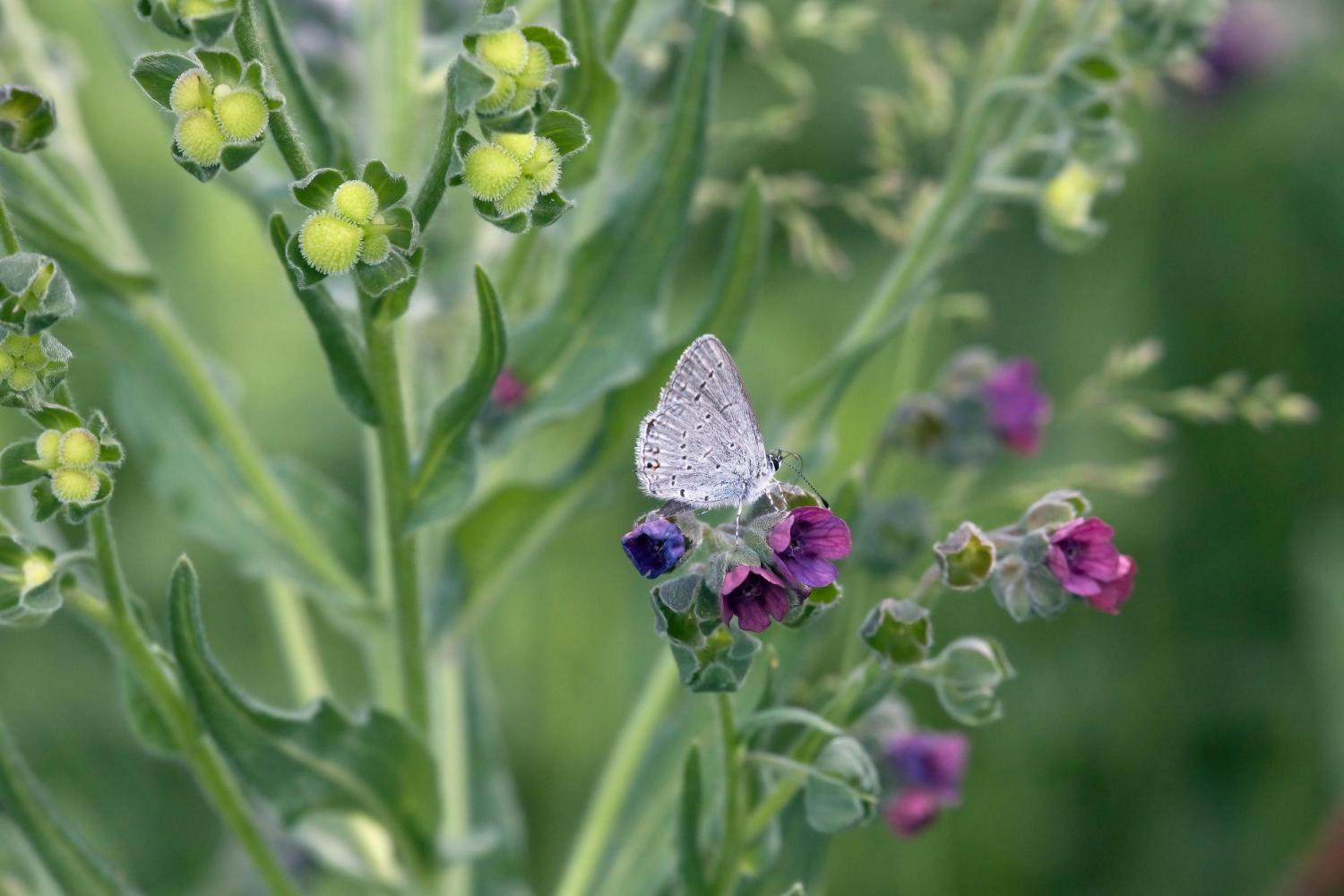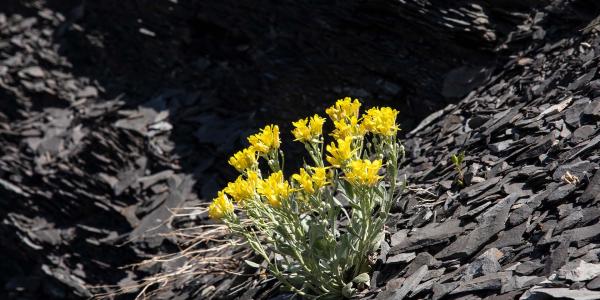Professor Emeritus takes a closer look at beautiful weeds with a lethal potential to kill livestock, and even, humans
After spending several hours stalking and photographing butterflies on Flagstaff Mountain west of Boulder, I returned home and spent about 10 minutes removing burs from my jeans and wool socks. I was annoyed, for if I only knew what plant bore those burs, I could give it a wide berth.
A year later, when processing my photo of a western tailed-blue (Cupido amyntula) on a cluster of flowers, I found the answer in the photograph. In the foreground were the flowers of houndstongue (Cynoglossum officinale). In the background were the maturing burs or seeds that were so annoying.
Houndstongue takes its common name from the similarity between its leaves and the tongue of a panting dog. Each leaf contains veins or groves that spread down to the distal or outer part of each leaf resembling a green tongue.
Houndstongue is native to the United Kingdom, northern Europe and northern Asia. It was thought to have been introduced to Canada in a contaminated shipment of seed before 1859. No one noticed the contaminated shipment, but specimens of houndstongue were collected in 1859 and deposited in a herbarium in Ontario. It was first reported in the United States in Oregon in 1893 and Montana in 1900. Today, houndstongues are in most of the 48 contiguous states and are listed as noxious weeds in seven western states, including Colorado.
A fertilized flower produces a fruit that is composed of four nutlets, which are thick-walled shells covered with barbed prickles and each containing one seed. (For simplicity, seeds, burs and nutlets will be called seeds). The seeds in the accompanying photo have a dense coat of straight green prickles. As the seeds dry, the prickles become barbed hooks, enhancing their ability to cling to animal hair. The seeds are dispersed by many species of mammalian wildlife, as well as cows, sheep, goats, horses and dogs.
The seeds—which hitchhike on sheep, cows, horses, dogs and hikers—are thoroughly annoying. Sheep wool can be so densely packed with nutlets that the fleece loses value. In the United Kingdom, people who take their retrievers for a walk or to retrieve ducks may spend an hour removing seeds from the dog's pelt and from wool hunting jackets. In the western United States, the seeds slow the marketing of cows, for they must be removed before cattle can be sold.
The seeds are annoying, but their plant defenses cause even greater problems. Like most species of plants, houndstongue has defenses that have evolved to discourage herbivores. Although it has no thorns, it has chemical defenses that are ingested by herbivores that eat its flowers, seeds, leaves and stems. It synthesizes four different pyrrolizidine alkaloids (PAs), which the liver converts to pyrrolic metabolites that cause tumors, damage nuclear DNA and halt protein synthesis in liver cells. So, PAs poison the liver and turn off the cell replication that may have replaced damaged liver cells.

A western tailed-blue butterfly on houndstongue flowers with seeds in the background. Image by Jeff Mitton.
PAs have killed humans, cows, horses, farmed deer, pigs, sheep, goats, poultry and quail. Horses are most susceptible, and sheep and goats are remarkably less susceptible with a tolerance to lethal doses 20 times higher than most animals. Most species of wildlife are not killed, but they learn not to graze on houndstongue. Because wildlife learns to avoid houndstongue, it has a competitive edge over the healthy sources of food both wildlife and cattle eat. In some places, this competitive edge allows houndstongue to become the dominant species, which greatly degrades the value of pastures for grazing.
PAs are synthesized by about 5% of all flowering plants and occur in 20 plant families. More than 600 forms of PAs have been described from the approximately 6,000 species that have been examined. None of these compounds are necessary for plant development, growth or reproduction—their functions are limited to plant defense against herbivores. The efficacy of these compounds can be seen in the speed of their invasion of Canada and the 48 contiguous states, despite efforts to eradicate or control them.
While clinging seeds and PAs give houndstongue a bad reputation, I must say that they have pretty flowers. Five petals fuse to form funnel-shaped flowers that appear from leaf axils and the tips of branches. The flowers are not one hue, but each flower has a combination of reds, blues and purples, so the flowers on one plant exhibit a range of colors. I will continue to enjoy the flowers, but I will approach only tentatively, avoiding seeds, and I certainly will not try the leaves in a salad.
Did you enjoy this article? Subcribe to our newsletter. Passionate about ecology and evolutionary biology? Show your support.
Top of page: Dry houndstongue seeds cling to the hair of wildlife and dogs and clothing. Image by Jeff Mitton.



